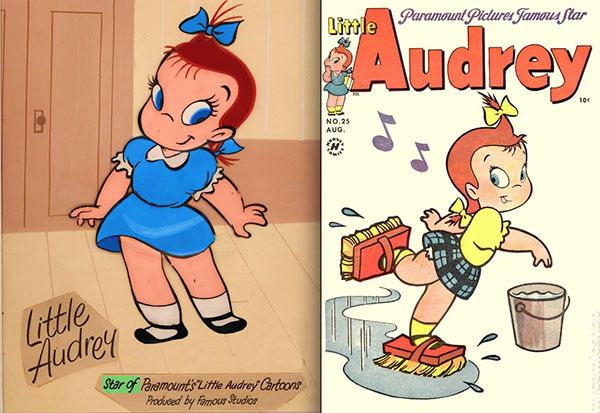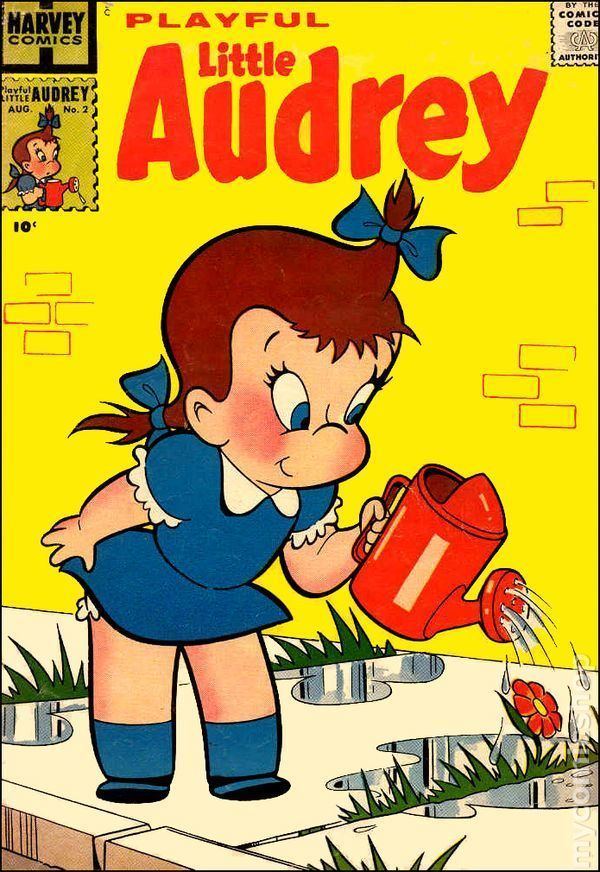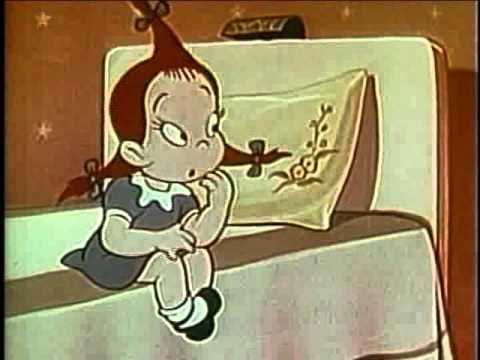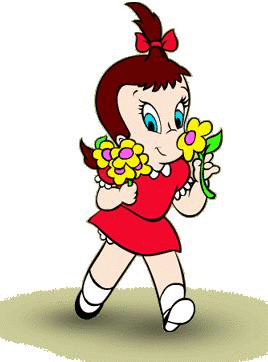Aliases Audrey Smith Nationality American | Gender Female | |
 | ||
Created by Seymour KneitelBill Tytla (design) Relatives Suzie (cousin)GrandmaPal (dog) Similar | ||
Little audrey song of the birds classic cartoon
Little Audrey (full name: Audrey Smith) is a fictional character, appearing in early 20th century folklore prior to her appropriation as the star in a series of Paramount Pictures' Famous Studios cartoons from 1947 to 1958. She is considered a variation of the better-known Little Lulu, devised after Paramount decided not to renew the license on the comic strip character created by Marjorie Henderson Buell (AKA: "Marge"). Despite some superficial similarities between the two characters, the Famous animators were at pains to design Audrey in contrast to Lulu, adopting an entirely different color scheme and employing the stylistic conventions common to Famous Studios' later 1940s repertoire, as opposed to Buell's individualistic rendering of Little Lulu. Veteran animator Bill Tytla was the designer of Little Audrey, reportedly inspired by his daughter Tammy (who was also his inspiration for Famous' version of Little Lulu, which he also worked on and directed several shorts with that character). The original voice of Little Lulu was performed by actress Cecil Roy (who also provided the voice of Casper the Friendly Ghost). Little Audrey was instead voiced by Mae Questel, who also voiced most of Paramount's other major female cartoon characters including Betty Boop and Olive Oyl.
Contents
- Little audrey song of the birds classic cartoon
- History
- In folklore and juvenile humor
- Animated cartoons
- Television era
- The FamousHarvey character
- In other media
- Comic strip
- Comic books
- Famous Studios filmography
- References

History

Prior to her adoption by Famous in 1947, Little Audrey had a long career in folklore as the butt of a series of mostly dirty jokes, some going as far back as the First World War.
In folklore and juvenile humor
According to B.A. Botkin's A Treasury of American Folktales:

Little Audrey is a folk-lore character about whom thousands of nonsensical short tales during the past five or six years — have been told. Sometimes Little Audrey parades as Little Emma or Little Gertrude, but she usually is recognizable by a catch phrase 'she just laughed and laughed'. The amusing incident is typically a catastrophe.

Pierre Berton, in The Dionne Years: A Thirties Melodrama (1978), offers this example of a Little Audrey joke as was in fashion around the time of the Dionne Quintuplets birth in 1934:

Little Audrey's mother asks her to buy some groceries at the Safeway, and she laughed and laughed because she knew there was no safe way.
One of the most famous goes like this:
One day, Li'l Audrey was playing with matches. Her mother told her she'd better stop before someone got hurt. But Li'l Audrey was awfully hard headed and kept playing with matches, and eventually she burned their house down.
"Oh, Li'l Audrey, you are sure gonna catch it when your father comes home!" said her mother.
But Li'l Audrey just laughed and laughed, because she knew her father had come home early to take a nap.
As nasty as some of these jokes were, they were extremely popular, and it became inevitable that someone would appropriate the name of the character.
Animated cartoons
Audrey first appeared in the Noveltoon' Santa's Surprise (1947), where she was the most prominent member of a multicultural child cast working to clean Santa's workshop while he was asleep, and was briefly seen in the January 1948 Popeye cartoon Olive Oyl for President. Her first starring vehicle was the short Butterscotch and Soda, released on July 16, 1948. In common with many animated shorts of the period, childlike fantasy played an important role in Audrey's early cartoons, which often used dream sequences as the basis of the storylines. In this way, Audrey could ride the clouds with Mother Goose (Goofy Goofy Gander, 1950), attend a wedding in Cakeland (Tarts and Flowers, also 1950), or face an underwater tribunal of outraged catfish (The Seapreme Court, 1954). Slapstick humor crept into the series with the release of Surf Bored (1953), which pitted the precocious little girl against a hulking but ultimately brainless life guard. A total of sixteen cartoons starring Audrey were produced for theatrical release, several of which were re-packaged for television from the late 1950s on.
She was the only character in the series to have their own theme song with vocals ("''Little Audrey Says''", by Winston Sharples and Buddy Kaye). Some other characters (and certain one-shots) in the series had their own themes, but were entirely instrumental. Two Noveltoons spin-offs, Casper the Friendly Ghost and Herman and Katnip had their own vocal themes, but only after leaving the series.
Television era
The pre-October 1950 Little Audrey cartoons were sold to television distributor U.M. & M. TV Corporation in 1956. The post-September 1950 cartoons would be sold to Harvey Comics, when they acquired the rights to the character in 1959. Today, they are the property of DreamWorks Animation, a subsidiary of NBCUniversal, and distributed by Universal Television. Meanwhile, Olive Oyl for President would become property of Warner Bros. (via Turner Entertainment Co.).
The Famous/Harvey character
Little Audrey's last name is Smith.
Little Audrey has reddish brown hair with ribbons making three pigtails. She wears a little dress with puffed sleeves, white ankle socks, and black Mary Jane shoes. In the short subjects, the dress and ribbons are blue, but by the time of her Harvey comics runs, they are red.
The comic "Little Audrey & Melvin and Cousin Suzie's Dance Party" (issue unknown) reveals that Audrey has a cousin named Suzie, who has a friend named Bubu. The first several issues of the comic book also reveals she has a brother nicknamed "Patches".
In other media
While the jokes remained popular well into the 1980s, the Famous/Harvey character had an entirely different career:
Comic strip
Animation historian Jerry Beck notes that Famous Studios' animator Steve Mufatti drew a short-lived "Little Audrey" comic strip for magazines in 1951, which were syndicated by King Features. These strips were also reprinted in 1952-55 by Harvey Comics.
Comic books
Little Audrey was never as successful as Famous' best-known creation, Casper the Friendly Ghost, but the character had considerable success in printed form. The first Little Audrey comic book series was St. John Publications from April 1948 to May 1952. Featuring stories which depended more on situation comedy than on fantasy, the comics featured artwork done in a style approximating the original Famous character designs (most of them by Steve Muffati). The series met with moderate success on the newsstand, running for approximately twenty-four issues until Little Audrey was licensed by Harvey Comics in 1952.
Initially, Harvey's comic-book version closely followed its animated template, but the character was redesigned during the mid-1950s to conform more closely to the company's in-house style. The general storyline was simultaneously overhauled to provide Audrey with supporting characters such as Melvin Wisenheimer, her ugly, prankish arch-rival, and Tiny, a young black boy. Domestic comedy gradually took over the scripts, as Audrey was shown in conflict with parents, teachers, and other authority figures.
Harvey purchased the rights to all of Famous' original properties - Little Audrey included - in 1958, also acquiring the rights to the post-1950 Audrey cartoons. It was during this time that the "definitive" Audrey came into being, taking on the signature red dress and appearance most often associated with the character. By 1960, Little Audrey was the best known of Harvey's female characters due to her multi-media presence (comic books, television/theatrical animation and - briefly - newspaper strips), although her popularity was later eclipsed by the company's other female characters, Little Dot, Wendy the Good Little Witch and Little Lotta.
Later comic series were titled Playful Little Audrey (The name under which the character has been trademarked in 1961) and Little Audrey & Melvin. In the latter, Audrey and Melvin become less antagonistic and Audrey demonstrates affections for and jealousy towards him, much like Little Lulu had done with Tubby Tompkins.
During her most successful period, Audrey starred in at least four of her own titles and was a back-up feature in Richie Rich, Casper, and Dot. The character lasted until 1976, when an industry-wide distribution slump brought an end to most of Harvey's line and most children's comics in general. Since that time, the character has undergone several revivals and made scattered television and video appearances, most notably in The Richie Rich Show (1996) and Baby Huey's Great Easter Adventure (1998).
Famous Studios filmography
All cartoons listed are entires in the series unless otherwise noted. Credited directors for each short are noted.
Note 1: These cartoons were rebroadcast as part of The Harveytoons Show (a.k.a. Casper and Friends), which aired in Canada on the now-defunct network Teletoon Retro.
Note 2: The first two cartoons (Santa's Surprise and Olive Oyl for President) are respectively part of the Noveltoons series for the first, and the Popeye the Sailor series instead for the second.
Note 3: The cartoon Song of the Birds is a remake of the homonym Max Fleischer Color Classic cartoon The Song of the Birds, which was released on March 1, 1935.
